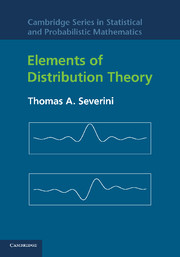Refine search
Actions for selected content:
2348 results in Statistical theory and methods
8 - Asymptotic Behavior of Estimators and Tests
-
- Book:
- From Finite Sample to Asymptotic Methods in Statistics
- Published online:
- 05 June 2012
- Print publication:
- 30 October 2009, pp 240-272
-
- Chapter
- Export citation
Index
-
- Book:
- From Finite Sample to Asymptotic Methods in Statistics
- Published online:
- 05 June 2012
- Print publication:
- 30 October 2009, pp 381-386
-
- Chapter
- Export citation

Elements of Distribution Theory
-
- Published online:
- 27 October 2009
- Print publication:
- 08 August 2005
Contents
-
- Book:
- Error and Inference
- Published online:
- 29 January 2010
- Print publication:
- 26 October 2009, pp vii-x
-
- Chapter
- Export citation
9 - Error and Legal Epistemology
-
-
- Book:
- Error and Inference
- Published online:
- 29 January 2010
- Print publication:
- 26 October 2009, pp 376-410
-
- Chapter
- Export citation
4 - Theory Confirmation and Novel Evidence
-
-
- Book:
- Error and Inference
- Published online:
- 29 January 2010
- Print publication:
- 26 October 2009, pp 125-169
-
- Chapter
- Export citation
2 - The Life of Theory in the New Experimentalism
-
-
- Book:
- Error and Inference
- Published online:
- 29 January 2010
- Print publication:
- 26 October 2009, pp 58-87
-
- Chapter
- Export citation
Frontmatter
-
- Book:
- Error and Inference
- Published online:
- 29 January 2010
- Print publication:
- 26 October 2009, pp i-vi
-
- Chapter
- Export citation
5 - Induction and Severe Testing
-
-
- Book:
- Error and Inference
- Published online:
- 29 January 2010
- Print publication:
- 26 October 2009, pp 170-201
-
- Chapter
- Export citation
Index
-
- Book:
- Error and Inference
- Published online:
- 29 January 2010
- Print publication:
- 26 October 2009, pp 411-419
-
- Chapter
- Export citation
8 - Causal Modeling, Explanation and Severe Testing
-
-
- Book:
- Error and Inference
- Published online:
- 29 January 2010
- Print publication:
- 26 October 2009, pp 331-375
-
- Chapter
- Export citation
List of Contributors
-
- Book:
- Error and Inference
- Published online:
- 29 January 2010
- Print publication:
- 26 October 2009, pp xi-xii
-
- Chapter
- Export citation
Introduction and Background
-
-
- Book:
- Error and Inference
- Published online:
- 29 January 2010
- Print publication:
- 26 October 2009, pp 1-27
-
- Chapter
- Export citation
6 - Theory Testing in Economics and the Error-Statistical Perspective
-
-
- Book:
- Error and Inference
- Published online:
- 29 January 2010
- Print publication:
- 26 October 2009, pp 202-246
-
- Chapter
- Export citation
7 - New Perspectives on (Some Old) Problems of Frequentist Statistics
-
-
- Book:
- Error and Inference
- Published online:
- 29 January 2010
- Print publication:
- 26 October 2009, pp 247-330
-
- Chapter
- Export citation
3 - Revisiting Critical Rationalism
-
-
- Book:
- Error and Inference
- Published online:
- 29 January 2010
- Print publication:
- 26 October 2009, pp 88-124
-
- Chapter
- Export citation
1 - Learning from Error, Severe Testing, and the Growth of Theoretical Knowledge
-
-
- Book:
- Error and Inference
- Published online:
- 29 January 2010
- Print publication:
- 26 October 2009, pp 28-57
-
- Chapter
- Export citation
Preface
-
- Book:
- Error and Inference
- Published online:
- 29 January 2010
- Print publication:
- 26 October 2009, pp xiii-xviii
-
- Chapter
- Export citation
15 - The Banach manifold of quantum states
- from Part III - Information geometry
-
-
- Book:
- Algebraic and Geometric Methods in Statistics
- Published online:
- 27 May 2010
- Print publication:
- 22 October 2009, pp 257-264
-
- Chapter
- Export citation
21 - Algebraic varieties vs. differentiable manifolds in statistical models
- from Part IV - Information geometry and algebraic statistics
-
-
- Book:
- Algebraic and Geometric Methods in Statistics
- Published online:
- 27 May 2010
- Print publication:
- 22 October 2009, pp 341-366
-
- Chapter
- Export citation
